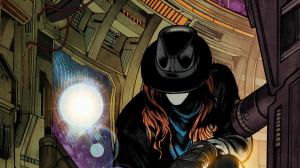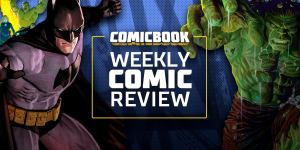
Videos by ComicBook.com
, out last week by Dan Jurgens and Aaron Lopresti, saw the team split up into smaller groups to combat the Signal Men cropping up around the world and the creatures hidden beneath them. Jurgens switches between the various duos (Booster Gold and Batman, Fire and Vixen, August General-in-Iron and Godiva, Rocket Red and Ice) deftly, weaving their findings in and out so as to prevent any one group from duplicating the experiences of the others until they come together at the end of the issue with the reintroduction of the missing Guy Gardner and our team’s first real interaction with master villain Peraxxus. Dan Jurgens joined us again this month to talk about the issue. Spoilers on, as always, as The International Exchange is a postgame analysis-type conversation and will discuss all aspects of the book, including potentially its last pages.The International Exchange: Is this the first time we’ve gotten “proper,” full-name-and-title introductions to Emerson and Briggs? I don’t remember last month for sure, but I’m pretty positive we didn’t get those captions in #1.Dan Jurgens: Captions? No. But they were duly introduced with first and last names on page 2 of Justice League International #1.IX: Kind of an odd question, but had you considered avoiding the term “JLI” for a while? It’s already being used here and while it’s something that would of course eventually develop, the “JL_” names are longstanding comic book shorthand, which even have a little baggage attached in the form of Grant Morrison’s JLA.DJ: I considered it for a bit, but the U.N.’s goal is so obvious here that it seeemed silly to avoid it. It’s clearly meant to be an international team of heroes the UN can control. And, of course, grabbing the JL portion of the name is designed to enhance credibility.IX: You know, Booster’s strategy of overloading the head because that’s where the sensory array should be is an interesting one—obviously the Signalmen are very kind of humanoid or anthropomorphic or something…but the only thing they haven’t used “like a human being would” yet is their heads.DJ: The giant’s behavior in #2 generally indicated some kind of perceptive abilities were in the head, especially when it threw it’s head back and seemed to be in contact with something up in the atmosphere. It was a natural conclusion for Booster to arrive at.IX: Despite having had a year to draw the other guys, there’s a lot of great Batman on the page from Aaron this month. As an artist yourself, is he just one of those characters that people try to stay “up” on, knowing that at any time you could be expected to draw a really dynamic Batman sequence?DJ: I don’t know if I’d phrase it quite that way. For me, I’d simply say Batman has a great and very unique design. You can’t not draw a great Batman sequence.IX: I like the fact that the Russian Navy refers to the JLI as “The UN’s special ops team.” Is that going to be the way that many ordinary people perceive the team?DJ: At this point, the public’s perceptions are and will continue to be all over the board.IX: “Bea will try anything once” is one of those statements that seems to return Fire to a pre- Checkmate (pre-angst) status quo. Booster’s personality is a bit of the same, so far, with everyone thinking of him first as a huckster. Without taking the characters all the way into bwa-ha-hah territory, are you trying to slide some of these guys back to where viewers of (for example) The Brave & the Bold would recognize them?
IX DJ IX DJ IX DJ IX DJ IX DJ IX DJ IX DJ IX DJ





